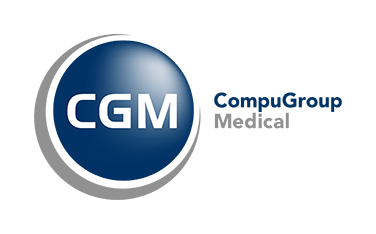Barcode printers and scanners may seem like a small part of the clinical laboratory, but they are a big first step toward creating an efficient and reliable workflow that can help your lab stand apart from the competition.
Patient care and lab efficiency
By implementing label printers and barcode scanners in your lab, your staff will enjoy fewer manual processes and errors, and everything from sample receipt to testing will become more efficient.
Beth Schmitt was a lab manager of a physician office lab for 30 years before joining the CompuGroup Medical team as the Sales Enablement Manager for the CGM SCHUYLAB Laboratory Information System. She has seen the benefit firsthand of implementing barcodes and labels in the lab.
"Barcode labels eliminate errors arising from illegible handwriting—of which I am guilty," Beth said.
"The phlebotomy staff are busy and scribble on the tubes. Writing on a flat surface is bad enough, but writing on a rounded surface is even worse."
Compounding the risk for errors, not every patient name fits on a label, and if a tech's handwriting is large, those names will run off the tube label and be lost.
"One of my pet peeves in the lab was when whoever labeled the tube decided to abbreviate the name because it was long or they were in a hurry," Beth said. "You can imagine the problems a tube labeled J. Smith would cause."
With a manual process, labs may also see errors when a technician mistypes an accession number into an analyzer.
"If you have an 8- or 10-digit number to type in, you will sometimes make an error and switch numbers around," Beth said. "When the test result goes over to the LIS, you would have to hunt to find whose sample this result really belonged to, or you would have to rerun the sample, costing the lab time and reagents."
Barcodes eliminate these issues.
What is a barcode?
As we've seen in stores countless times, a standard UPC barcode is made up of many parallel, black-and-white lines of various widths and combinations.
These lines encode an identification sequence. In the grocery store, this sequence relates to a manufacturer code and an item number. In the laboratory, the sequence correlates to an accession number.
Similar to how a register at the grocery store looks up an item number to find the current sales price, the laboratory information system (LIS) relies on its database to connect the accession number to the patient name, the list of tests ordered, and any other relevant information.
There is a reason the LIS does most of the work and a barcode contains only an accession number.
If the barcode itself contained testing information, this information could not easily be changed. For instance, if the barcode were to contain the test ‘glucose,’ then you would be in trouble when the doctor added on the rest of the comprehensive metabolic panel, or CMP. Because the barcode contains only the accession number, the information linked to that number can be altered at will. A particular accession could mean just a glucose test one minute, and a whole CMP the next. This allows for the dynamic flexibility needed in a laboratory environment.
Hardware requirements & consumables
To realize the efficiencies afforded by barcodes and labels, your lab will need barcode scanners and label printers along with the analyzers that run your tests.
For labs using the CGM LABDAQ Laboratory Information System, the CGM Shop Lab website offers handheld barcode readers as well as two Zebra-brand label printers and cases of the labels that work with them.
This hardware integrates with the LIS to streamline the flow of data throughout the laboratory.
Barcodes for unidirectional instruments
A unidirectional instrument cannot receive data from an LIS, but it can transmit information to it. Many unidirectional instruments—for example, most hematology instruments—can read barcodes to collect accession numbers and transmit them to the LIS with their corresponding test results. These instruments generally perform a single test or panel, so there is no selection of test options. In this case, barcodes eliminate the need for a lab tech to stand next to the instrument, typing in accession numbers. The tubes are placed in a rack, and the tests are performed as the barcodes are scanned by the instrument.
Barcodes for host-query instruments
Host-query instruments can communicate more fully with the LIS, so barcodes really shine when these analyzers are used. With host-query instruments, barcodes not only replace the manual entry of accession numbers, they eliminate the need for a tech to send a worksheet to the instrument, or otherwise program it with orders. Instead, a host-query instrument reads a barcode and asks the LIS to send the appropriate instructions for each accession. The LIS responds with a list of tests, and the instrument performs those tests before transmitting the results back to the LIS.
With barcodes, labels, powerful lab management software, and the right analyzer interfaces, your lab can leave manual processes behind and enjoy an improvement in turnaround times and the integrity of patient and test result data. More results. Less effort. Happier staff.
